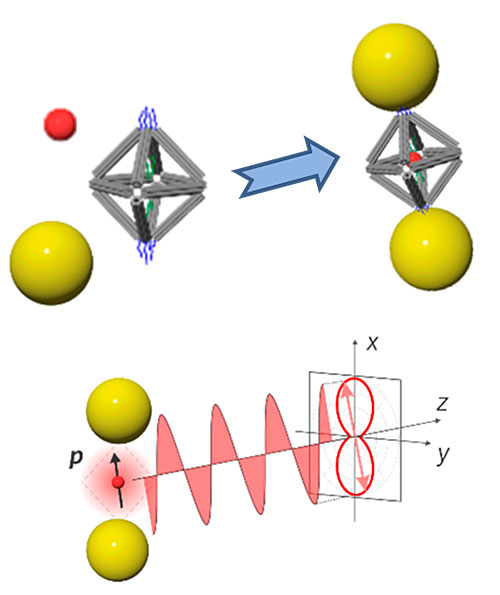Designing Polarized Light Emitters with DNA
December 30, 2020
 enlarge
enlarge
(Top) A schematic of a programmed assembly of a polarized light-emitting cluster from quantum dot (red), gold nanoparticle (yellow), and DNA origami (grey) components. (Bottom) The gold nanoparticle antennae create a cluster architecture such that the light emitted from the quantum dot is polarized.
What is the scientific achievement?
CFN researchers and collaborators designed and realized polarized light emitters by self-assembly of nanocomponents. Using DNA origami to mediate optical device assembly, the team programmed coordination of semiconductor quantum dots (QDs) within a DNA octahedron and plasmonic gold nanoparticle (AuNP) antennae at appropriate octahedron vertices. Polarized light emission is due to the metal nanoparticle configuration effect on the quantum dot electromagnetic environment within the cluster architecture.
Why does this achievement matter?
Creating nanoscale polarized light emitters is challenging but needed for communications and information processing. The DNA origami platform is a particularly useful method for programmable design and assembly of such cluster architectures.
What are the details?
Although the fluorescence and lifetimes of nanoscale emitters can be manipulated by plasmonic materials, polarization is harder to control because of strict requirements on emitter environments. An ability to engineer 3D nanoarchitectures with nanoscale precision is needed for controlled polarization of nanoscale emitters. This work shows that prescribed 3D cluster architectures with polarized emission can be successfully assembled from nanoscale fluorescent emitters and metallic nanoparticles using DNA-based self-assembly methods. An octahedral DNA origami frame serves as a programmable scaffold for heterogeneous nanoparticle assembly into prescribed clusters. Internal spaces and external connections of the frames are programmed to coordinate spherical QDs and gold nanoparticles AuNPs into cluster architectures through site-specific DNA encodings.
The team demonstrated and characterized assembly of these architectures using in situ and ex situ structural methods. The cluster nanodevices exhibit polarized light emission with a plasmon-induced dipole along the QD-AuNP nanocluster axis, as observed by single-cluster optical probing. Moreover, emittance properties can be tuned via cluster design. Through a systematic study, they analyzed and established the correlation between cluster architecture, cluster orientation, and polarized emission at a single-emitter level. Excellent correspondence between the optical behavior of the clusters and theoretical predictions was observed. This approach provides the basis for rational creation of single-emitter 3D nanodevices with controllable polarization output using a highly customizable DNA assembly platform.
CFN Capabilities
CFN Materials Synthesis & Characterization and Advanced Optical Microscopy Facilities were used in this study.
Publication Reference
H. Zhang, M. Li, K. Wang, Y. Tian, J.-S. Chen, K.T. Fountaine, D. DiMarzio, M. Liu, M. Cotlet, O. Gang. Polarized Single-Particle Quantum Dot Emitters through Programmable Cluster Assembly, ACS Nano 14, 1369 (2020).
DOI: https://doi.org/10.1021/acsnano.9b06919
Acknowledgement of Support
This research used resources of the Center for Functional Nanomaterials and the National Synchrotron Light Source II (Complex Materials Scattering, CMS beamline), which are U.S. DOE Office of Science Facilities at Brookhaven National Laboratory under Contract DE-SC0012704. The work on DNA-nanoparticle assembly was supported by the US Department of Energy, Office of Basic Energy Sciences, Division of Materials Sciences and Engineering, under Grant DE-SC0008772. The work was supported in part by NG Next, Northrop Grumman Corporation.
2020-17692 | INT/EXT | Newsroom









